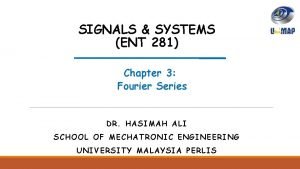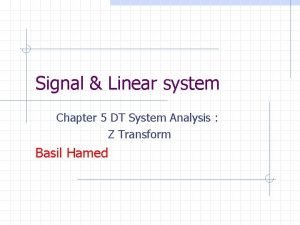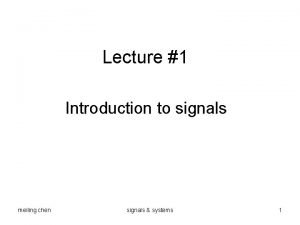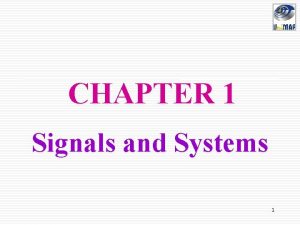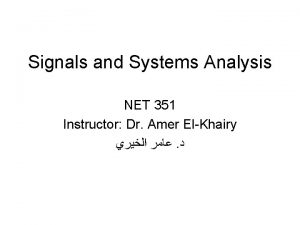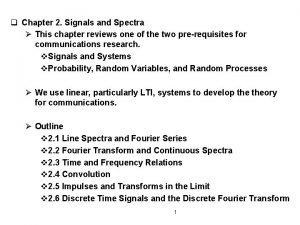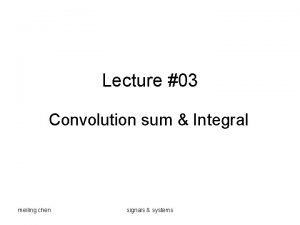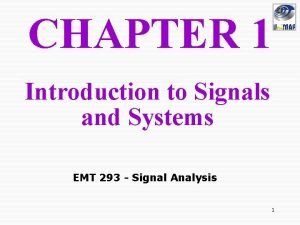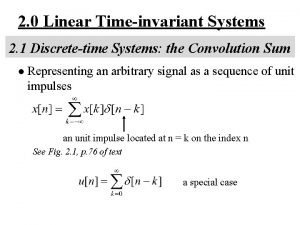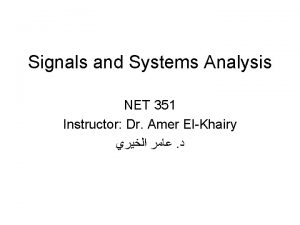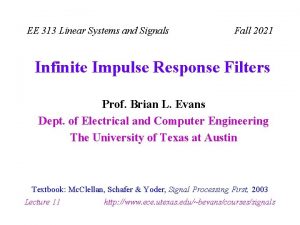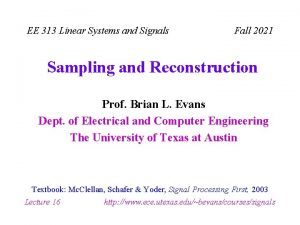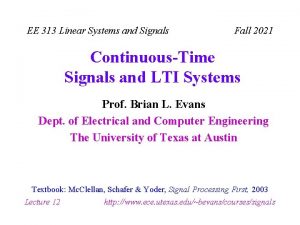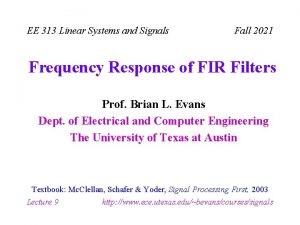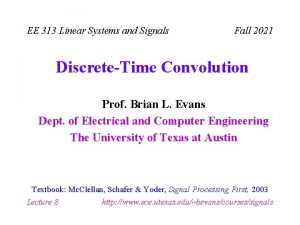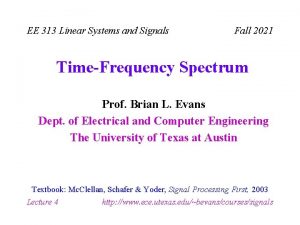EE 313 Linear Systems and Signals Fall 2021












- Slides: 12

EE 313 Linear Systems and Signals Fall 2021 Continuous-Time Convolution Prof. Brian L. Evans Dept. of Electrical and Computer Engineering The University of Texas at Austin Textbook: Mc. Clellan, Schafer & Yoder, Signal Processing First, 2003 Lecture 13 http: //www. ece. utexas. edu/~bevans/courses/signals

Continuous-Time Signals and LTI Systems – SPFirst Ch. 9 -4 Linear Systems and Signals Topics Domain Topic Discrete Time Signals SPFirst Ch. 2 ✔ ✔ SPFirst Ch. 5 ✔ SPFirst Ch. 9 ✔ SPFirst Ch. 5 ✔ SPFirst Ch. 9 ** SPFirst Ch. 3 ✔ ✔ SPFirst Ch. 6 ✔ SPFirst Ch. 11 SPFirst Ch. 6 ✔ SPFirst Ch. 10 SPFirst Ch. 7 -8 ✔ Supplemental Text SPFirst Ch. 8 ✔ SPFirst Ch. 9 SPFirst Ch. 4 ✔ SPFirst Ch. 12 Systems Convolution Frequency Fourier series Fourier transforms Frequency response Generalized Frequency z / Laplace Transforms Transfer Functions System Stability Mixed Signal Sampling Continuous Time SPFirst Ch. 4 ** Spectrograms (Ch. 3) for time-frequency spectrums (plots) computed the discrete-time Fourier series for each window of samples. 13 -2

Continuous-Time Signals and LTI Systems – SPFirst Sec. 9 -4 Systems • Systems operate on signals to produce new signals or new signal representations • Linear time-invariant system x(t) T{ • } y(t) d(t) T{ • } h(t) x(t) T{ • } y(t) Uniquely defined by its impulse response Output in time domain is convolution of impulse response and input • Continuous-time convolution 13 -3

Continuous-Time Signals and LTI Systems – SPFirst Sec. 9 -5 LTI System Examples • Ideal delay by T seconds Initial conditions must be zero for LTI properties to hold x(t) y(t) apply sifting property • Gain x(t) y(t) apply sifting property 13 -4

Continuous-Time Signals and LTI Systems – SPFirst Sec. 9 -4 Convolution Properties • Definition • Properties Commutative: f 1(t) * f 2(t) = f 2(t) * f 1(t) Distributive: f 1(t) * [f 2(t) + f 3(t)] = f 1(t) * f 2(t) + f 1(t) * f 3(t) Associative: f 1(t) * [f 2(t) * f 3(t)] = [f 1(t) * f 2(t)] * f 3(t) Shift: If f 1(t) * f 2(t) = c(t), then f 1(t) * f 2(t – T) = f 1(t – T) * f 2(t) = c(t – T) 13 -5

Continuous-Time Signals and LTI Systems – SPFirst Sec. 9 -5 LTI System Examples • Integrator (initial condition is zero) x(t) y(t) 1 if t ≥ t • Tapped delay line M-1 delay blocks Initial conditions in delay blocks must be 0 Impulse response lasts for (M-1) T seconds: … … S 13 -6

Continuous-Time Signals and LTI Systems – SPFirst Sec. 9 -7 Graphical Convolution Methods • From its definition, convolution is equivalent to Rotating one of the functions about the y axis Shifting it by t Multiplying this flipped, shifted function with other function Calculating the area under this product Assigning this value to f 1(t) * f 2(t) at t • Sometimes called “flip-and-slide” convolution 13 -7

Continuous-Time Signals and LTI Systems – SPFirst Sec. 9 -7 Graphical Convolution Example • Convolve two signals: f(t) g(t) 3 2 * t t 2 -2 2 • Replace t with t in f(t) and g(t) • Choose to flip and slide g(t) since it is simpler and symmetric 3 g(t-t) • Functions overlap like this: 2 -2 + t f(t) 2+t 2 t 13 -8

Continuous-Time Signals and LTI Systems – SPFirst Sec. 9 -7 Graphical Convolution Example • Convolution can be divided into 5 parts I. t < -2 • • -2 t < 0 II. • • 3 Two functions do not overlap Area under the product of the functions is zero g(t-t) 2 -2 + t Part of g(t-t) overlaps part of f(t) Area under the product of the functions is f(t) 2 2+t 3 g(t-t) 2 -2 + t t f(t) 2+t 2 t 13 -9

Continuous-Time Signals and LTI Systems – SPFirst Sec. 9 -7 Graphical Convolution Example III. 0 t < 2 • • Here, g(t-t) completely overlaps f(t) Area under the product is just 3 2 f(t) 2 2+t -2 + t IV. 2 t < 4 • • Part of g(t-t) and f(t) overlap Calculated similarly to -2 t < 0 t 4 V. • • g(t-t) t 3 g(t-t) 2 f(t) -2 + t 2+t g(t-t) and f(t) do not overlap Area under their product is zero 13 -10

Continuous-Time Signals and LTI Systems – SPFirst Sec. 9 -7 Graphical Convolution Example • Result of convolution (5 intervals of interest): y(t) 6 t -2 0 2 Check values at interval endpoints to validate answer 4 13 -11

Continuous-Time Signals and LTI Systems – SPFirst Sec. 9 -7 Convolution Demos • Johns Hopkins University Demonstrations http: //pages. jh. edu/~signals/ Convolution applet to animate convolution of simple signals and hand-sketched signals Convolve two rectangular pulses of same width gives a triangle (see handout E) • Some conclusions from the animations Convolution of two causal signals gives a causal result Non-zero duration (called extent) of convolution is the sum of extents of the two signals being convolved 13 -12
 Communicative signals and informative signals
Communicative signals and informative signals Communicative signals and informative signals
Communicative signals and informative signals Communicative signals and informative signals
Communicative signals and informative signals Parseval's equation
Parseval's equation Signals and systems oppenheim solutions chapter 5
Signals and systems oppenheim solutions chapter 5 Shifting and scaling of signals
Shifting and scaling of signals Precedence rule in signals and systems
Precedence rule in signals and systems Convolution sum in signals and systems
Convolution sum in signals and systems Synthesis equation fourier series
Synthesis equation fourier series Convolution sum and convolution integral
Convolution sum and convolution integral Introduction to signals and systems
Introduction to signals and systems Convolution sum in signals and systems
Convolution sum in signals and systems Signals and system
Signals and system



